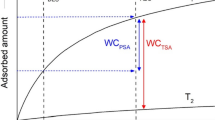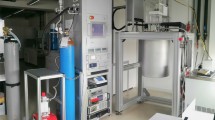Abstract
To calculate a gas sorption isotherm from measurements made using the manometric (Sieverts) technique requires accurate knowledge of the sample cell void volume, the volume able to be occupied by the free gas. For many combinations of material and morphology, this volume changes as the sample expands or compresses, swells, undergoes chemical change or adsorbs gas. For gas adsorption measurements on porous materials, the volume of the adsorbate is often accepted as the pore volume, and the adsorbate density changes as the material adsorbs. For materials exhibiting IUPAC type I isotherms, including many carbons, the uptake saturates at high pressures and additional information about the volume (adsorption space) and density of the adsorbate can be extracted at high pressure, provided adsorption has finished. For hydrogen, this typically requires cryogenic temperatures at pressures up to 10 MPa. In this work, hydrogen isotherms are conducted at pressures up to 200 MPa, in order to investigate the properties of the adsorbate at ambient temperatures. In addition, the manometric method gas uptake equations for absolute, excess and net isotherms are revisited and extrapolated to high pressure in order to extract information on the adsorbate volume and density, and enable the construction of the absolute isotherm.



Similar content being viewed by others
Data availability
Experimental data available from corresponding author on request.
Code availability
Not applicable.
References
Bernardo, P., Drioli, E., Golemme, G.: Membrane gas separation: a review/state of the art. Ind Eng Chem Res 48(10), 4638–4663 (2009). https://doi.org/10.1021/ie8019032
Pullumbi, P., Brandani, F., Brandani, S.: Gas separation by adsorption: technological drivers and opportunities for improvement. Curr Opin Chem Eng 24, 131–142 (2019). https://doi.org/10.1016/j.coche.2019.04.008
Abunowara, M., Bustam, M.A., Sufian, S., Eldemerdash, U.: Measurement techniques for carbon dioxide sorption capacity on various coal samples: critical review. IOP Conf Ser Earth Environ Sci 36, 012059 (2016). https://doi.org/10.1088/1755-1315/36/1/012059
Kemp, K.C., Seema, H., Saleh, M., Le, N.H., Mahesh, K., Chandra, V., Kim, K.S.: Environmental applications using graphene composites: water remediation and gas adsorption. Nanoscale 5(8), 3149–3171 (2013). https://doi.org/10.1039/C3NR33708A
Burnett, D.J., Heng, J.Y.Y., Thielmann, F., Garcia, A.R., Naderi, M., Acharya, M.: Measuring surface roughness of pharmaceutical powders using vapor sorption methods. AAPS PharmSciTech 12(1), 56–61 (2011). https://doi.org/10.1208/s12249-010-9571-0
Rudkevich, D.M.: Emerging supramolecular chemistry of gases. Angew Chem Int Ed Engl 43(5), 558–571 (2004). https://doi.org/10.1002/anie.200300606
Wang, J., Trinkle, D., Derbin, G., Martin, K., Sharif, S., Timmins, P., Desa, D.: Moisture adsorption and desorption properties of colloidal silicon dioxide and its impact on layer adhesion of a bilayer tablet formulation. J Excip Food Chem 5(1), 1004 (2016)
Opatokun, S., Azhagapillai, P., Shoaibi, A., Srinivasakannan, C., Strezov, V.: Food wastes derived adsorbents for carbon dioxide and benzene gas sorption. Chemosphere 168, 327 (2017). https://doi.org/10.1016/j.chemosphere.2016.10.083
Panda, D., Patra, S., Awasthi, M.K., Singh, S.K.: Lab cooked MOF for CO2 capture: a sustainable solution to waste management. J Chem Educ 97(4), 1101–1108 (2020). https://doi.org/10.1021/acs.jchemed.9b00337
Rashed, M.N.: Organic pollutants: monitoring, risk and treatment. BoD–Books on Demand, (2013)
Darkrim, F.L., Malbrunot, P., Tartaglia, G.P.: Review of hydrogen storage by adsorption in carbon nanotubes. Int J Hydrogen Energy 27(2), 193–202 (2002). https://doi.org/10.1016/s0360-3199(01)00103-3
Sakintuna, B., Lamaridarkrim, F., Hirscher, M.: Metal hydride materials for solid hydrogen storage: a review. Int J Hydrogen Energy 32(9), 1121–1140 (2007). https://doi.org/10.1016/j.ijhydene.2006.11.022
Gray, E.M.: Reliable measurement of hydrogen uptake. In: Walker, G. (ed.) Solid-state hydrogen storage, pp. 174–204. Woodhead Publishing Ltd, Cambridge (2008)
Poirier, E., Chahine, R., Tessier, A., Bose, T.K.: Gravimetric and volumetric approaches adapted for hydrogen sorption measurements with in situ conditioning on small sorbent samples. Rev Sci Instrum 76(5), 055101 (2005). https://doi.org/10.1063/1.1891647
Blach, T.P., Gray, E.M.: Sieverts apparatus and methodology for accurate determination of hydrogen uptake by light-atom hosts. J Alloys Compd 446–447, 692–697 (2007). https://doi.org/10.1016/j.jallcom.2006.12.061
Sircar, S.: Measurement of gibbsian surface excess. AIChE J 47(5), 1169–1176 (2001). https://doi.org/10.1002/aic.690470522
Gumma, S., Talu, O.: Net adsorption: a thermodynamic framework for supercritical gas adsorption and storage in porous solids. Langmuir 26(22), 17013–17023 (2010). https://doi.org/10.1021/la102186q
Myers, A.L., Monson, P.A.: Adsorption in porous materials at high pressure: theory and experiment. Langmuir 18(26), 10261–10273 (2002). https://doi.org/10.1021/la026399h
Neimark, A.V., Ravikovitch, P.I.: Calibration of pore volume in adsorption experiments and theoretical models. Langmuir 13(19), 5148–5160 (1997). https://doi.org/10.1021/la970266s
Newcombe, G., Drikas, M.: Adsorption of NOM onto activated carbon: electrostatic and non-electrostatic effects. Carbon 35(9), 1239–1250 (1997). https://doi.org/10.1016/s0008-6223(97)00078-x
Humayun, R., Tomasko, D.L.: High-resolution adsorption isotherms of supercritical carbon dioxide on activated carbon. AIChE J 46(10), 2065–2075 (2000). https://doi.org/10.1002/aic.690461017
Menon, P.G.: Adsorption at high pressures. Chem Rev 68(3), 277–294 (1968). https://doi.org/10.1021/cr60253a002
Bastos-Neto, M., Patzschke, C., Lange, M., Möllmer, J., Möller, A., Fichtner, S., Schrage, C., Lässig, D., Lincke, J., Staudt, R., Krautscheid, H., Gläser, R.: Assessment of hydrogen storage by physisorption in porous materials. Energy Environ Sci (2012). https://doi.org/10.1039/c2ee22037g
Moellmer, J., Moeller, A., Dreisbach, F., Glaeser, R., Staudt, R.: High pressure adsorption of hydrogen, nitrogen, carbon dioxide and methane on the metal–organic framework HKUST-1. Microporous Mesoporous Mater 138(1–3), 140–148 (2011). https://doi.org/10.1016/j.micromeso.2010.09.013
Poirier, E., Dailly, A.: Investigation of the hydrogen state in IRMOF-1 from measurements and modeling of adsorption isotherms at high gas densities. J Phys Chem C 112(33), 13047–13052 (2008). https://doi.org/10.1021/jp800981f
Poirier, E., Dailly, A.: On the nature of the adsorbed hydrogen phase in microporous metal-organic frameworks at supercritical temperatures. Langmuir 25(20), 12169–12176 (2009). https://doi.org/10.1021/la901680p
Poirier, E., Dailly, A.: Thermodynamic study of the adsorbed hydrogen phase in Cu-based metal-organic frameworks at cryogenic temperatures. Energy Environ Sci 2(4), 420 (2009). https://doi.org/10.1039/b818393g
Poirier, E., Dailly, A.: Thermodynamics of hydrogen adsorption in MOF-177 at low temperatures: measurements and modelling. Nanotechnology 20(20), 204006 (2009). https://doi.org/10.1088/0957-4484/20/20/204006
Poirier, E., Dailly, A.: Saturation properties of a supercritical gas sorbed in nanoporous materials. Phys Chem Chem Phys 14(48), 16544–16551 (2012). https://doi.org/10.1039/c2cp40722a
Pini, R.: Interpretation of net and excess adsorption isotherms in microporous adsorbents. Microporous Mesoporous Mater 187, 40–52 (2014). https://doi.org/10.1016/j.micromeso.2013.12.005
Voskuilen, T.G., Pourpoint, T.L., Dailly, A.M.: Hydrogen adsorption on microporous materials at ambient temperatures and pressures up to 50 MPa. Adsorption 18(3–4), 239–249 (2012). https://doi.org/10.1007/s10450-012-9397-z
Brandani, S., Mangano, E., Sarkisov, L.: Net, excess and absolute adsorption and adsorption of helium. Adsorption 22(2), 261–276 (2016). https://doi.org/10.1007/s10450-016-9766-0
Broom, D.P., Webb, C.J.: Pitfalls in the characterisation of the hydrogen sorption properties of materials. Int J Hydrogen Energy 42(49), 29320–29343 (2017). https://doi.org/10.1016/j.ijhydene.2017.10.028
Yun, K.S., Zhu, C., Parcher, J.F.: Theoretical relationships between the void volume, mobile phase volume, retention volume, adsorption, and gibbs free energy in chromatographic processes. Anal Chem 67(3), 613–619 (1995). https://doi.org/10.1021/ac00099a020
Keller, J.U., Staudt, R.: Gas asorption equilibria, experimental methods and adsorptive isotherms Springer Science, (2005)
Webb, C.J., Gray, E.M.: The effect of inaccurate volume calibrations on hydrogen uptake measured by the Sieverts method. Int J Hydrogen Energy 39(5), 2168–2174 (2014). https://doi.org/10.1016/j.ijhydene.2013.11.121
Myers, A.L., Monson, P.A.: Physical adsorption of gases: the case for absolute adsorption as the basis for thermodynamic analysis. Adsorption 20(4), 591–622 (2014). https://doi.org/10.1007/s10450-014-9604-1
Sircar, S.: Gibbsian surface excess for gas adsorption revisited. Ind Eng Chem Res 38(10), 3670–3682 (1999). https://doi.org/10.1021/ie9900871
Alvarez, P., Garcia-Araya, J., Beltrán, F., Masa, F., Medina, F.: Ozonation of activated carbons: effect on the adsorption of selected phenolic compounds from aqueous solutions. J Colloid Interface Sci 283(2), 503–512 (2005). https://doi.org/10.1016/j.jcis.2004.09.014
Canizares, P., Carmona, M., Baraza, O., Delgado, A., Rodrigo, M.A.: Adsorption equilibrium of phenol onto chemically modified activated carbon F400. J Hazard Mater 131(1–3), 243–248 (2006). https://doi.org/10.1016/j.jhazmat.2005.09.037
Dastgheib, S.A., Karanfil, T., Cheng, W.: Tailoring activated carbons for enhanced removal of natural organic matter from natural waters. Carbon 42(3), 547–557 (2004). https://doi.org/10.1016/j.carbon.2003.12.062
Garnier, C., Gorner, T., Razafitianamaharavo, A., Villieras, F.: Investigation of activated carbon surface heterogeneity by argon and nitrogen low-pressure quasi-equilibrium volumetry. Langmuir 21(7), 2838–2846 (2005). https://doi.org/10.1021/la047948h
Morlay, C., Joly, J.-P.: Contribution to the textural characterisation of Filtrasorb 400 and other commercial activated carbons commonly used for water treatment. J Porous Mater 17(5), 535–543 (2009). https://doi.org/10.1007/s10934-009-9322-3
Skodras, G., Diamantopoulou, I., Natas, P., Palladas, A., Sakellaropoulos, G.P.: Postcombustion measures for cleaner solid fuels combustion: activated carbons for toxic pollutants removal from flue gases. Energy Fuels 19(6), 2317–2327 (2005). https://doi.org/10.1021/ef050112h
Tsang, D.C.W., Hu, J., Liu, M.Y., Zhang, W., Lai, K.C.K., Lo, I.M.C.: Activated carbon produced from waste wood pallets: adsorption of three classes of dyes. Water Air Soil Pollut 184(1–4), 141–155 (2007). https://doi.org/10.1007/s11270-007-9404-2
Yue, Z., Economy, J., Rajagopalan, K., Bordson, G., Piwoni, M., Ding, L., Snoeyink, V.L., Mariñas, B.J.: Chemically activated carbon on a fiberglass substrate for removal of trace atrazine from water. J Mater Chem 16(33), 3375–3380 (2006). https://doi.org/10.1039/b606679h
Poirier, E.: Ultimate H2 and CH4 adsorption in slit-like carbon nanopores at 298 K: a molecular dynamics study. RSC Adv 4(44), 22848–22855 (2014). https://doi.org/10.1039/c4ra02553a
Acknowledgement
L. N. acknowledges receipt of a Griffith University PhD scholarship.
Funding
Griffith University internal support.
Author information
Authors and Affiliations
Corresponding author
Ethics declarations
Conflict of interest
None.
Additional information
Publisher's Note
Springer Nature remains neutral with regard to jurisdictional claims in published maps and institutional affiliations.
Rights and permissions
About this article
Cite this article
Naheed, L., Lamb, K.E., Gray, E.M. et al. Extracting adsorbate information from manometric uptake measurements of hydrogen at high pressure and ambient temperature. Adsorption 27, 1251–1261 (2021). https://doi.org/10.1007/s10450-020-00289-2
Received:
Revised:
Accepted:
Published:
Issue Date:
DOI: https://doi.org/10.1007/s10450-020-00289-2




